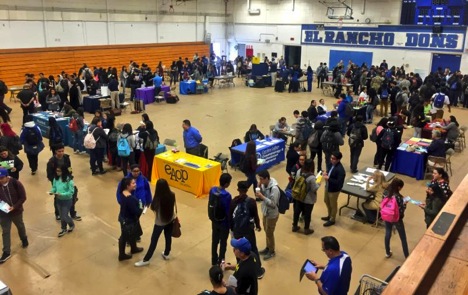I consider myself a teacher at heart but often find myself wearing different hats. In recent months, I have been rotating hats between that of a college counselor, the education reformer for better college access pathways, and that of a researcher hoping to shed light on what is working and what is not. Through my research for my master’s thesis focused on college access, I came across a tremendous wealth of information regarding strategies being used and analyzed at different high schools and evaluations of impact. I wanted to share some information that has helped me better evaluate my own district’s system of “college-linking” and the processes in place to help support them.
Using data from the High School Effectiveness Study, an analysis developed by the University of Michigan identified three distinctive “college-linking” strategies: traditional, clearinghouse, and brokering. These college-linking strategies include the process of planning, application, and decision making that culminate in enrollment in college. The analysis suggested that school resource structures and norms for facilitating college transition were an important mechanism through which schools influenced college success (Hill, D., 2008). While these three strategies were formulated after studying hundreds of high schools, the use of each strategy had different outcomes in which some students were left out from being supported to have a successful transition into postsecondary education.
For the purpose of providing concrete information, the three strategies will be defined and described, but one will be emphasized as the dominant strategy with the most positive outcomes for supporting the transition for Latino students, specifically in an urban high school setting (Hill, D., 2008).
The “traditional strategy” is characterized by limited resource capacity and a limited organizational commitment to facilitating access to available resources among students and their families; this concept is consistent with the role that high schools traditionally played through much of the 20th century. This strategy is often linked to the way high schools in predominantly low-income neighborhoods, with a concentrated population of minority students, set up their college culture: existent by definition but with little commitment to embed it within the high school’s day to day. (Picture a school that claims to provide students exposure to curriculum that will prepare them for college and perhaps even make a public statement about its commitment to creating more college pathways- yet there is no clear system in place to follow through with its promises.)
The “clearinghouse strategy,” is characterized by a clear resource structure for college planning with a limited commitment to the equitable distribution of resources that help students and their parents navigate the college linking process. Thus, high schools who take a minor role in distributing these resources to families and students, operate primarily as a clearinghouse for resources, as they do not commit to ensuring all students have access and support services in place. This strategy has also been known to affect high schools in urban settings as there is little effort to build a college-going culture within the community. (Picture a school that has an active AVID program that hosts college nights but does not commit to ensuring ALL students are aware of college night.)
Lastly, the “brokering strategy” is characterized by a substantial amount of resources and a strong organizational commitment to affording students and families access to resources (Hill, D., 2008). Thus, a high school acts as a broker for its own resources, facilitating access and taking on an influential role in the college-linking process, which further supports a successful transition to college. For the purpose of this blog, I want to focus on the “brokering strategy” as it is important to understand what strategies work in order to make high schools accountable. It is through the brokering strategy that schools can do more than simply promote the availability of resources; it is essential for them to also be purposeful in coordinating the distribution and access to these resources in order to facilitate the transition to postsecondary education. Now picture this: before selecting classes, incoming sophomores meet one-on-one with a counselor to set a college plan and discuss the different pathways available to them. In addition, parents are personally invited to also meet and discuss the different opportunities available. Does this sound like something your high school is providing? Well, believe it or not, this is technically what should be happening at every high school. Given this information, what strategy does your high school use? And is your school making the impact you wished for?*
Alma Renteria
Latest posts by Alma Renteria (see all)
- Rincón Universitario: Cómo Escribir una Narrativa Auténtica para Solicitudes de Universidades, Parte 3 - October 17, 2019
- College Corner: How To Write An Authentic Narrative for College Applications, Part 3 - October 15, 2019
- Rincón Universitario: Cómo Escribir Una Narrativa Auténtica para Solicitudes Universitarias, Parte 2 - October 1, 2019
- College Corner: How To Write An Authentic Narrative for College Applications, Part 2 - September 26, 2019
- College Corner: Cómo Escribir un Relato Auténtico de Solicitudes para la Universidad, Parte 1 - September 4, 2019

